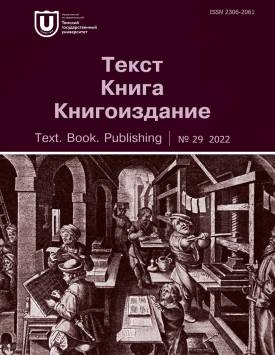Non-standard graphic realizations in modern printed texts
The article deals with violations of the callitypical norms regulating the use of fonts and compositional-spatial signs in a printed text. Norms and deviations of this type are represented in the modern orthology field, despite fundamental technical and technological changes in the media sphere. The theoretical foundations of the work trace their origin to papers on the functional and aesthetic aspect of printed graphics (E. Adamov, V. Toots, E.V. Oleshko, J. Tschichold, R. Bringhurst) and to orthological studies of callitypical norms (J. Vachek, A.A. Reformatsky, B.S. Schwarzkopf). The empirical basis was publications in Argumenty i Fakty and Cosmopolitan Russia for 2019. The author has revealed the following types of nonstandard callitypical realizations using the method of a systemic-functional analysis: total font accentuation (20 units); graphic overprotection (2 units); incorrect use of graphic markers in the main part of the texts (7 units); graphic polysemy and homonymy (72 units); graphic synonymy (51 units); non-normative compositional-spatial variants (5 units). All of them are associated with violations of semiotic symmetry between the signifier and the signified, which is characteristic of rigid systems, including printed language. These non-standard uses differ in terms of motivation, representing creative techniques (total font accentuation, graphic overprotection, ideographic synonymy) or callitypical mistakes (other non-standard variants). Units of the first type, when used appropriately, increase the expressiveness of printed tests; units of the second type complicate the solution of communicative tasks and reduce the level of the speech culture. The author pays attention to the criteria of callitypical normativity and shows that here, as in other orthological areas, the systems principle is in complicated interactions with traditional prescriptions. The study of graphic deviations proves that the callitypical norm creates clear architectonics and provides functional navigation. Therefore, it is advisable to comply with these requirements both in the press and in other types of printing product. The author declares no conflicts of interests.
Keywords
orthology,
printed text graphics,
callitypical norm,
callitypical deviation,
font,
print layout,
media communicationAuthors
| Khakimova Elena M. | South Ural State University | khakimova-elena@yandex.ru |
Всего: 1
References
Вахек Й. Письменный язык и печатный язык // Пражский лингвистический кружок : сб. ст. М. : Прогресс, 1967. С. 535-543.
Мак-Люэн М. Галактика Гутенберга. Сотворение человека печатной культуры. Киев : Ника-Центр, 2004. 432 с.
Daniel D., Woody W. E-textbooks at what cost? Performance and use of electronic v. print texts // Computers & Education. March 2013. Vol. 62. P. 18-23. URL: https://www.sciencedirect.com/science/article/abs/pii/S0360131512002448 (дата обращения: 09.04.2019).
Latini N., Braten I., Anmarkrud 0., Salmeron L. Investigating effects of reading medium and reading purpose on behavioral engagement and textual integration in a multiple text context // Contemporary Educational Psychology. October 2019. Vol. 59. URL: https://www.sciencedirect.com/science/article/pii/S0361476X18305381tfb0020 (дата обращения: 09.04.2019).
Российская полиграфия. Состояние, тенденции и перспективы развития. М., 2020. 63 c. URL: http://www.unkniga.ru/images/docs/2020/otr-doklad-poligrafiya-2019-1.pdf (дата обращения: 09.04.2021).
Российская периодическая печать. Состояние, тенденции и перспективы развития. М., 2020. 123 c. URL: http://www.unkniga.ru/images/docs/2020/otr-doklad-periodika-2019-1.pdf (дата обращения: 09.04.2019).
Вольская Н. Н. Поликодовый медиатекст: пути исследования // Русская речь. 2016. № 2. C. 58-63.
Казак М.Ю. Специфика современного медиатекста // Современный дискурсанализ. 2012. № 1 (6). C. 30-41.
Сподарец О.О. Невербальные средства в новостном печатном в новостном печатном медиа-дискурсе // Интеллектуальный потенциал XXI века. 2010. № 4-1. C. 241-245.
Чернявская В.Е. Лингвистика текста: Поликодовость, интертекстуальность, интердискурсивность. М. : Либроком, 2009. 248 с.
The Content is The Queen. URL: https://t.me/s/thecontentisthequeen (дата обращения: 09.04.2021).
Адамов Е. Ритмическая структура книги. М. : Книга, 1974. 94 с.
Тоотс В. Современный шрифт. М. : Книга, 1966. 271 c.
Олешко Е.В. Новые информационные технологии как фактор формирования и развития шрифтовой культуры изданий // Известия Уральского государственного университета: Се. 1: Проблемы образования, науки и культуры. 2010. № 81 (4). С. 143149.
Рогач Ю.И. Визуально-графические особенности масс-медийных текстов СМИ Австралии // Язык и культура. 2013. № 9. С. 237-242.
Харькова О.В. Шрифт как инструмент воздействия на массовое сознание в прессе Третьего Рейха // Вестник Московского университета. Серия 9. Филология. 2008. № 1. С. 71-78.
Tschichold J. The new typography. University of California Press, 2006. 288 p.
Bringhurst R. The elements of typographic style. Vancouver, BC, Canada : Hartley & Marks Publishers, 2004. 351 p.
Щерба Л.В. Языковая система и речевая деятельность. Л. : Наука, 1974. 428 c.
Реформатский А.А. Техническая редакция книги. М. : Гизлегпром, 1933. 416 с.
Шварцкопф Б.С. Современная русская пунктуация: система и ее функционирование. М. : Наука, 1988. 192 с.
Хакимова Е.М. Ортологическая система современного русского языка: онтологические основания лингводеонтического: дис.. д-ра филол. наук. Челябинск, 2015. 547 с.
Бюлер К. Теория языка: Репрезентативная функция языка. М. : Прогресс, 2000. 502 с.
Добросклонская Т.Г. Методы анализа видео-вербальных текстов. Медиалингвистика. 2016. № 2. С. 13-25.
Лебедев А. Делать фонт болдом или италиком? 28 декабря 2001 г. URL: https://www.artlebedev.ru/kovodstvo/sections/79/(дата обращения: 09.04.2021).
АиФ-Челябинск. 2010, 2019.
Гессен Л.И. Оформление книги. Руководство по подготовке рукописи к печати. Л. : ОГИЗ, 1935. 337 с.
Туголукова Е.Н., Денисова А.О. Основные факторы удобочитаемости в вузовских печатных СМИ. Дизайн-макетирование изданий // Графический дизайн: история и тенденции современного развития. СПб., 2016. С. 278-281.
Никишина Е.А. Речевой жанр писем читателей в газеты (на материале эмигрантских и советских газет 20-х гг. XX в. : автореф. дис.. канд. филол. наук. М., 2013. 29 с.
Cosmopolitan Россия. 2019.
Справочная книга редактора и корректора. Редакционно-техническое оформление издания / сост. и общ. ред. А.Э. Мильчина; кодирование в HTML А.Д. Лысенко. URL: http://www.az-print.com/FAQ/HelpBook/index.shtml (дата обращения: 09.04.2021).
Лебедев А. Теория близости. 2006. 24 авг. URL: https://www.artlebedev.ru/kovodstvo/sections/136/(дата обращения: 09.04.2021).
Виноградов С.И. Нормативный и коммуникативно-прагматический аспекты культуры речи // Культура русской речи и эффективность общения. М. : Наука, 1996. С. 121-152.
Данеш Ф. Позиции и оценочные категории при кодификации // Новое в зарубежной лингвистике: Вып. 20: Теория литературного языка в работах ученых ЧССР / пер. с чешского А.Н. Кондрашова. М. : Прогресс, 1987. С. 281-295.

